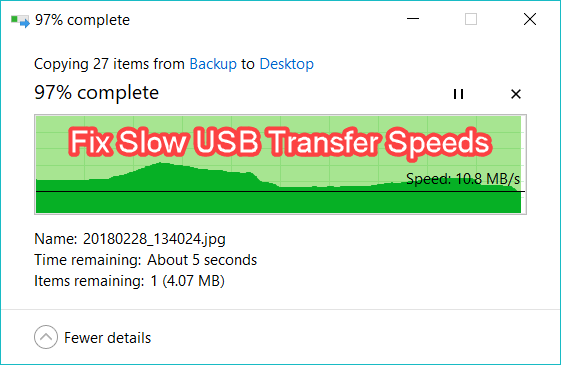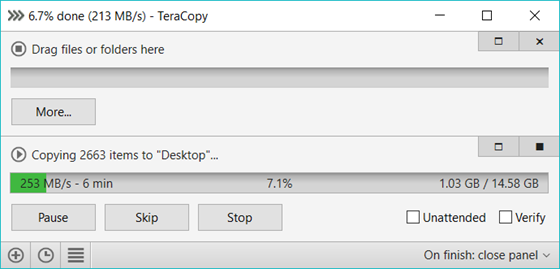How to Speed up USB 3.0/2.0 Transfer in Windows 10
In the fast-paced world of the technology, there are many resources in regard to electronics playing part in enhancing lives. Data transfer is a highly used technology paralleling your computer peripherals and smart technology devices. Yes, you heard it right? We are talking about the small equipment flash drive “USB Drive”, through which your data is transferred hassle-free. But there is always a hack of causes, fixes, and step by step guide to get the best use of the resources. It’s necessary to stay above the competitive range of the advancing hacks and advancements.

With the speedy technology of refined research, USB port is now available to tablets, laptops, TVs and so on, so you can easily plug USB drives into them. If you are facing the issues of the slow speed with the transfer of the files, here are a few guides to increase the data transfer with a flash drive. Let’s see some common causes of a slow run of the Flash Drive.
Possible Causes of Slow USB transfer Speeds
Here we are discussing only possible reasons that cause accidentally drops on USB drive transfer speed, like from 500MB/s to 2MB/s, especially after some changes on computer or USB stick.
- Upgrade to Windows 10 from Windows 7 or Windows 8
- Format USB flash drive, for example, in order to transfer large files to FAT32
In these cases, actions, like “Better performance” optimization, turning off Windows Defender or disabling some settings, may not work, or at least won’t make significant difference.
Solution 1. Fix Slow USB Transfer Speeds by Updating USB Driver
If the transfer speed of your USB drive slows down after upgrading computer to Windows 10, then there is possibly a driver issue.
Update driver from Windows Update
When you upgrade from Windows 7 or 8 to Windows 10, there may exist compatibility problem on USB driver. However, Microsoft is keep releasing updates for Windows 10 to fix known errors. Make sure you didn’t disable Windows 10 update completely, then follow steps below.
- Step 1. Go to Settings > Update & security > Windows Update.
- Step 2. Check pending updates. You should get a preview of available updating items.
- Step 3. Start the update. Save all opened work in case computer restarts itself after update.
- Step 4. Reboot computer if it doesn’t and check if USB transfer speed is increased.
Update USB controller driver from Device Manager
- Step 1. Press Windows key + X at the same time, then select Device Manager.
- Step 2. Expand Universal Serial Bus controllers.
- Step 3. Right-click on a USB driver and choose Update drive. Follow the guide to complete update. Repeat and update all drivers
- Step 4. Restart computer and check if this speeds up USB transfer.
You can also go to your computer manufacturer’s website and download latest USB drivers for Windows 10.
Solution 2. Fix Slow USB Transfer Speeds by Formatting to exFAT or NTFS
It is actually not suggested format a new USB drive unless it is really necessary. Some premium USB drives, especially those made by giant manufacturers, are built with best structure and alignment, which may lose after formatting. However, if the USB transfer speed is already slowed down, you may give it a try.
Usually, USB disk drives come with FAT32 file system. Depending on future application scenarios, you can format USB drive as NTFS or exFAT. Generally speaking, NTFS is better working in Windows computers, while exFAT is better in Mac.
- Step 1. Back up your USB drive data, then connect it to a Windows computer.
- Step 2. Open Windows Explorer (My Computer), then right click the USB drive and choose Format…
- Step 3. Set File System as NTFS (or exFAT), untick Quick format.
- Step 4. Click Start, then choose OK to confirm and start formatting.
Now test the USB transfer speed after formatting. In case you lose important files due to formatting, please a try a professional data recovery software.
Solution 3. Speed up USB Transfer by Using Copy Utility
If none of the above tricks work for you, then you can consider a third-party utility to replace default Explorer for USB file transfer. TeraCopy is one of the most famous copy utilities. It has a lot of useful features that Windows Explorer doesn’t provide. It also works for some people (if not everyone) to speed up USB transfer.

With the technology shaping the people lives with the small devices, latest USB 3.0 and 3.1 are very speedy for file copy and transfer. It is worth of effort to try those solutions in order to keep and speed up USB transfer. Tell us your cases and get helpful suggestion now!